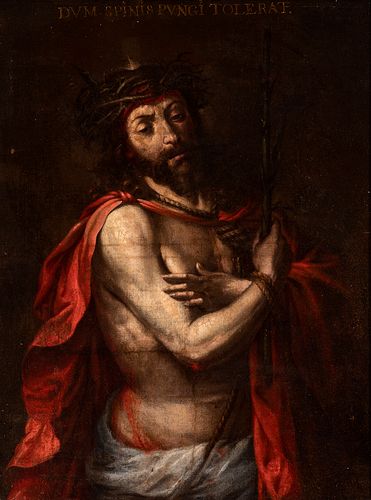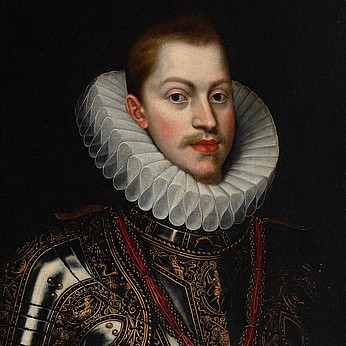Sevillian master; second third of the seventeenth century. "Ecce homo". Oil on canvas. Relined.
Lot 84
About Seller
Setdart Auction House
Carrer Aragó 346
Barcelona
Spain
Setdart Subastas was born in 2004 and is currently the first online art auction in Spain with solidity, prestige and reliability guaranteed by our more than 60,000 users. Setdart has a young, dynamic and enterprising team ready to successfully manage the purchase and sale of art works through custom...Read more
Estimate:
EUR€20,000 - EUR€25,000
$21,505.38 - $26,881.72
Absentee vs Live bid
Two ways to bid:
- Leave a max absentee bid and the platform will bid on your behalf up to your maximum bid during the live auction.
- Bid live during the auction and your bids will be submitted real-time to the auctioneer.
Bid Increments
| Price | Bid Increment |
|---|---|
| EUR€0 | EUR€10 |
| EUR€200 | EUR€25 |
| EUR€500 | EUR€50 |
| EUR€1,000 | EUR€100 |
| EUR€3,000 | EUR€200 |
| EUR€5,000 | EUR€500 |
| EUR€10,000 | EUR€1,000 |
| EUR€20,000 | EUR€2,000 |
| EUR€50,000 | EUR€5,000 |
About Auction
By Setdart Auction House
Nov 24, 2021
Set Reminder
2021-11-24 09:00:00
2021-11-24 09:00:00
America/New_York
Bidsquare
Bidsquare : Old Masters, Day 1
https://www.bidsquare.com/auctions/setdart-auction-house/old-masters-day-1-7873
Setdart Auction House sofia@setdart.com
Setdart Auction House sofia@setdart.com
- Lot Description
Sevillian master; second third of the seventeenth century. "Ecce homo". Oil on canvas. Relined. Measurements: 108.5 x 85 cm; 134 x 109 cm (frame). The author of this devotional work conceives the theme of Ecce Homo, through the use of a simple and clear composition, with the face of Christ in the foreground, the absence of narrative details deepens the expressive power and pathos, designed to move the mood of the faithful who prays before the image, within a tremendist sense very typical of the baroque in Catholic countries. Formally, this work faithfully follows the guidelines of baroque naturalism, defined by the work of Juan Valdés Leal. Thus, visually dominates the light treatment, very contrasted and effective, based on a spotlight that falls directly on the figure of Christ, creating expressive effects of chiaroscuro and leaving the rest in semi-darkness, on a dark and neutral background that further enhances the physical presence of the character. The chromatism also derives directly from the models mentioned above and is therefore based on a restricted and warm palette, enormously nuanced, of ochre, earthy and carmine tones. The theme of Ecce Homo belongs to the cycle of the Passion, and precedes the episode of the Crucifixion. Following this iconography, Jesus is presented at the moment when the soldiers mock him, after crowning him with thorns, dressing him in a purple tunic (here red, symbolic color of the Passion) and placing a reed in his hand, kneeling and exclaiming "Hail, King of the Jews!". The words "Ecce Homo" are those pronounced by Pilate when presenting Christ before the crowd; their translation is "behold the man", a phrase by which he mocks Jesus and implies that the power of Christ was not such in front of that of the leaders who were judging him there. Juan Váldes Leal (Seville, 1622 - 1690) was an artist strictly contemporary of Murillo, he was his greatest pictorial rival in the Seville of his time. The comparison between the two painters has been frequent, artificially encouraged by the character of the works of both: if Murillo's was seen as the very expression of gentleness and calm, the harshness and dramatism of Valdés Leal's work and, above all, the extreme truculence of his best known works, the vánitas of the church of La Caridad in Seville, serve to confirm the dichotomy. But, in spite of the difficult character with which he is portrayed in the sources, the truth is that Valdés Leal's work is quite varied and is in line with the painting that was being done in his environment. We do not know at what date he moved to Cordoba, although it is likely that he had already received his first artistic training in his native city. It has been speculated that he was close to the workshop of Herrera el Viejo, and also to the art of the Cordovan Antonio del Castillo, as possible influences for his first known signed and dated work, the San Andrés de la iglesia de San Francisco de Córdoba, from 1647. In it he combined with visible success the monumentality of the figure of the saint with a naturalistic approach. In 1656 he settled in Seville, where he spent most of his life. In 1660 he was one of the founders of the Academy of Drawing, of which he became president in 1663. The following year Palomino established his trip to the court and to El Escorial, a journey that can still be understood as an apprenticeship, driven by his eagerness to know the works of the great masters present in the royal collections. In 1667 he joined the Brotherhood of Charity of Seville, whose founder had been Miguel de Mañara, the noble visionary author of the eschatological Discourse of Truth, to which Valdés would remain attached from then on. In 1671, Valdés Leal had the opportunity to work as an architect on the ephemeral decorations that the cathedral of Seville had installed to celebrate the canonization of Saint Ferdinand.
- Shipping Info
-
In-house shipping available. Please inquire at admin@setdart.com.
-
- Buyer's Premium



 EUR
EUR CAD
CAD AUD
AUD GBP
GBP MXN
MXN HKD
HKD CNY
CNY MYR
MYR SEK
SEK SGD
SGD CHF
CHF THB
THB

















